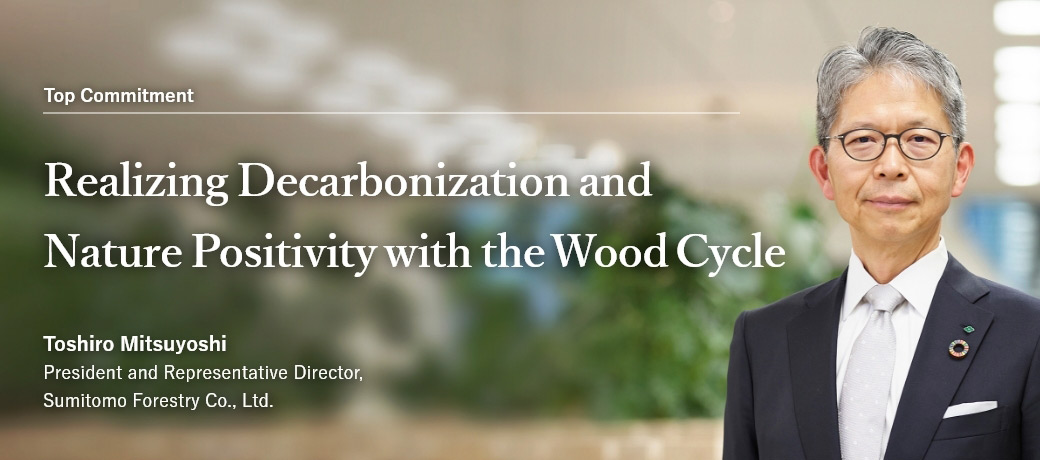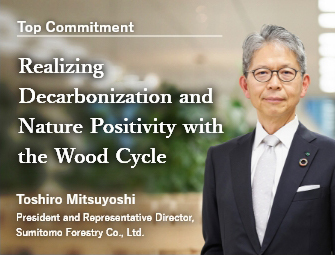- Home
- Sustainability Report
- Top Commitment
Top Commitment


A year of transformation toward 2030
This year, important national elections are being held in countries that are home to 4 billion people, half the world's population. The British magazine Economist has positioned 2024 as an unprecedented election year. According to the Global Risks Report issued by the World Economic Forum held at the beginning of the year, the top three most serious long-term risks for the next decade are extreme weather, critical change to Earth systems, and biodiversity loss and ecosystem collapse. When natural resource shortages and pollution are added, half of the top 10 risks are related to the environment. Short-term risks include misinformation and disinformation, cyber insecurity, societal polarization, inflation, and economic downturn. While these issues will affect electoral results in various countries in various ways, long-term environment-related efforts to build a sustainable society remain immediately pressing.
For Sumitomo Forestry, 2024 is the final year of Phase 1 of the Mid-Term Management Plan as part of our long-term vision Mission TREEING 2030 announced in February 2022. At the same time, it is also the time to formulate Phase 2 of the Mid-Term Management Plan. Now in my fifth year as CEO, I am certain that 2024 will become an important milestone year to look back on to in many respects.
Contributing to the decarbonization of society through our Wood Cycle
In our long-term vision Mission TREEING 2030, which outlines what type of company we want to be in 2030, the same target year as the SDGs, we aim to provide value for the global environment, for people and society, and for the market economy. We are committed to promoting business activities that simultaneously enhance all three values without sacrificing any of the other values. As one of our business policies, we have set out to maximize the value of forests and wood to realize decarbonization and a circular bio-economy. As a first step, Sumitomo Forestry Group has focused on initiatives to increase CO2 absorption and sequestration in the forestry, timber and construction sectors through our value chain, the Wood Cycle. For example, our SBT target to achieve a 54.6% greenhouse gas emissions reduction by 2030 compared to fiscal 2017 levels, we almost achieved that target by significantly reducing the coal co-firing rate at the Mombetsu Biomass Power Plant. Furthermore, this January, we reformulated our short and long-term reduction targets and newly submitted FLAG (forests, land and agriculture) targets in accordance with the latest SBT guidance. In addition, we launched a number of initiatives described below that we believe will contribute to decarbonization not only for our own operations, but for the whole of society as well.
In the area of forests, we formed and began managing our first forestry fund in the United States in June 2023 as part of our effort to accelerate the circular forestry business. To date, we have acquired a total of 112,580 acres (approximately 45,600 hectares) of forest assets in New York, Virginia and West Virginia. To achieve our goal to expand the forest area we own and manage to 500,000 hectares by 2030, we are now forming a second fund in Japan and Southeast Asia. In Indonesia, we are utilizing the peatland management technologies we developed in Kalimantan to standardize methods to measure biomass growth and CO2 emissions in tropical peatlands. At the same time, we are working to promote our consulting business for peatland restoration projects through NeXT FOREST, a joint venture with IHI.
In the area of timber, we will increase the use of domestic logs and ensure a stable product supply by establishing timber industrial complexes, which promote the diverse values of timber, such as its ability to sequester carbon. As our first effort, we collaborated with Koei Shizai Co., Ltd., and Wada Mokuzai Ltd. to establish Kowa no Mori Inc. in Iwaki-Yotsukura Central Industrial Park, Iwaki, Fukushima Prefecture, in November of last year. This new factory will manufacture processed wood products using primarily Japanese cedar and is scheduled to begin operations in March 2026.
None of these efforts can be achieved by a single company alone but require collaboration with other companies and a systemic change of society, including changes in rules and regulations.
Moving toward the standardization of carbon neutral design for buildings
From the perspective of societal transformation, the most progress this year may be in the field of architecture where we have made a commitment to standardize carbon neutral design. Until now, the construction sector has been divided into architectural design, structural design, materials, equipment, construction and other processes and has not been collectively viewed as a built environment. At COP 28 held in Dubai last year, 28 countries including Japan launched the Buildings Breakthrough (BBT), an effort to make zero emissions and resilient buildings in the construction sector the new normal by 2030.
The Buildings and Climate Global Forum took place this March in Paris, France, attended by some 1,800 ministers and high-level representatives from 70 countries around the world. Dedicated to accelerating decarbonization and climate change resilience of the construction sector, the participants adopted the Declaration de Chaillot, a significant step forward for an industry that is responsible for almost 40 percent of the world’s GHG emissions. Sumitomo Forestry had an opportunity to speak at this event. We communicated that the use of wood and wood construction could significantly reduce embodied carbon, in particular, GHG emissions from raw material procurement and processing, the transport of building materials, and the construction and demolition of buildings.
The Ministry of Land, Infrastructure, Transport and Tourism is now considering making calculations of embodied carbon mandatory by 2030. One Click LCA, a software for which we are the exclusive distributor in Japan, aligns with international ISO standards and conforms to global environmental certifications. Because products that have acquired EPD (Environmental Product Declaration) can be used for calculations, it reflects the emission reduction efforts of timber and building materials manufacturers. One Click LCA is gaining high regard among developers, general contractors and architectural firms and will hopefully become the standard tool for carbon neutral design in Japan. The aforementioned Declaration de Chaillot also advocates the setting and mandating of upper limits on emissions (whole life carbon) for all processes in the construction sector, which we believe will further increase interest in wooden buildings.
To capture expanding market demand for medium- to large-scale wooden buildings, we completed construction of a 15-story wooden and partially reinforced concrete office building in Melbourne, Australia, in October last year. This year, we began construction of wooden office buildings in the United States and the United Kingdom. In Japan, we are accelerating collaboration with general contractors, such as Kumagai Gumi Co., Ltd., to build wood hybrid buildings. We are also promoting real estate development projects to construct wooden lodging and other facilities.
Towards a nature positive society
In addition to our decarbonization initiatives, Sumitomo Forestry Group seeks to conduct business that is conscious of biodiversity to raise the value of forest resources and other forms of natural capital. In line with disclosure recommendations issued by the Taskforce on Nature-related Financial Disclosures (TNFD) in September 2023, we conducted analyses using the LEAP approach (an integrated approach to locate the interface with nature, evaluate dependencies and impacts on nature, assess nature-related risks and opportunities, and other). Despite time constraints, we were able to conduct analyses of four out of five of our business segments and disclosed information on a trial basis that integrated our TNFD analysis of climate-related risks and opportunities. We also registered as a TNFD Early Adopter to express our intention to disclose TNFD information simultaneously with our financial information from 2025.
Following the June 2023 announcement of the International Sustainability Standards Board (ISSB) standards for the disclosure of non-financial information, the Sustainability Standards Board Japan (SSBJ) released a draft this March for Japan. It will be open for public comment until the end of July and decided upon in March 2025. Afterwards, early adoption will be possible from the business year starting on or after April 1, 2025. For the time being, climate-related and non-financial information related to human capital will be targeted but it is almost a certainty that nature-related information will be added in the near future. In addition to continuing to conduct analyses and disclosure in accordance with TNFD recommendations, we will accelerate our initiatives to conserve and restore nature so that we can contribute to the realization of nature positivity.
Creating a diverse and inclusive organization that values fairness and trust
With non-financial information now being incorporated into statutory disclosure documents where accuracy is essential, we are now tasked with the need to improve the efficiency of collecting non-financial data from group companies. While accessing the laws, regulations and other rules for each of our growing business operations and business locations, we will work to enhance corporate value by setting up proper internal controls, ensuring employee conscientiousness about compliance, and disclosing information that stakeholders find relevant and worthy.
We have implemented a new personnel and evaluation system to reinforce our human resources development and retention efforts. The system seeks to maximize our overall strength as an organization by enabling the quick identification and selection of outstanding personnel. At the same time, with our Declaration on Health Management formulated in 2021 and our DEI Declaration, we have made a commitment to create an inclusive organization and workplace so that our diverse group of employees can work energetically and in good health.
Ever since our establishment in 1691, Sumitomo Forestry has sought to provide value not only for our own operations but also for the whole of society in line with our thinking, “Benefit self and benefit others, private and public interests are one and the same.” By actively promoting DX (digital transformation) and SX (sustainability transformation) and working together with our many business partners both in Japan and overseas, all of us at Sumitomo Forestry Group are committed to fulfilling Mission TREEING 2030 and contributing to the creation of a sustainable and prosperous society.
- Home
- Sustainability Report
- Top Commitment

